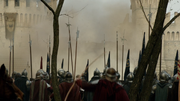The Siege of Forli (19 December 1499-12 January 1500) was a siege action of the Italian War of 1499-1504. Cesare Borgia's Papal and French armies laid siege to Caterina Sforza's fortress of Forli, and they succeeded in exploiting a tunnel beneath the defensive walls to breach the city's defenses. Caterina Sforza was captured during the fall of her stronghold, which was a major Papal victory.
Background[]
In 1499, Pope Alexander VI allied himself with King Louis XII of France in return for the King's support in establishing the Pope's son, Cesare Borgia, as ruler in Romagna. The House of Borgia had a score to settle with Caterina Sforza, who had resisted siege from the Borgia in 1497, and who had made multiple attempts to kill the Pope (including sending hitmen tin kill the Pope at his palace, sending her assassin Rufio and her spy Pascal to sow intrigue in Rome, and sending a plague-bearing handkerchief to the Pope, which ended up afflicting Cardinal Carlo Constanzo instead). On 9 March 1499, the Pope reversed the investiture of the lords of the Romagna, and a French army left Milan to support Borgia's campaign in the Romagna. Borgia and his generals Paolo and Roberto Orsini, Gian Paolo Baglioni, and Vitellozzo Vitelli were granted permission by the Pope and the Florentine diplomat Niccolo Macchiavelli to quietly march through Florentine territory at night to reach Forli, where they would meet up with French troops already in place around the city. On 24 November 1499, the inhabitants of Caterina Sforza's fortress of Imola opened the fortress gates to the Papal forces without resistance, and Cesare's army was in a position to besiege "the Spider of Forli"'s main stronghold by December.
Siege[]

The walls of Forli crumbling
Caterina Sforza ordered for every ounce of grain and for all poultry and livestock to be brought to the castle of Forli, planning to resist enemy siege. She also planned to have much of the forest surrounding the castle cut down, seeking to create a clear field of fire. Sforza anticipated that it would take ten days for the besiegers to arrive, but camouflaged French troops began to arrive in the forest as she made her plans to build defensive fortifications. Soon, Borgia and his Papal troops arrived, and they began to attack the walls with artillery. The walls were twelve-feet thick, resisting the bombardments by Vitelli's cannon, but the people began to panic; winter was setting in, and they began to starve. The tide turned when Borgia's lieutenant Micheletto Corella informed him of an old Roman quarry that ran under the north tower of Forli, and he told Borgia to bombard the spot; the tower would fall, and a breach would open in the defenses. Borgia attempted to negotiate with Sforza, but she said that she "would never bow to the Whoremaster of Rome". The besiegers' cannon proceeded to fire several volleys at the weak point, and the ignorant defenders laughed it off, thinking that the besiegers had missed the walls. However, the walls collapsed after the mine shaft began to collapse, and the besiegers charged into the city. They overwhelmed the defenders, and Cesare Borgia eventually entered the city and ordered for the fighting to stop, hoping to avoid a massacre. Caterina Sforza threatened to hang herself rather than be captured, but an arquebusier shot the rope as she jumped, and Borgia caught her. He had her chained and sent to a palace in Rome for imprisonment, where she would later have her lips cut off. Forli's fall was a major victory for the Papal forces, as the House of Sforza's power had now met its end.
